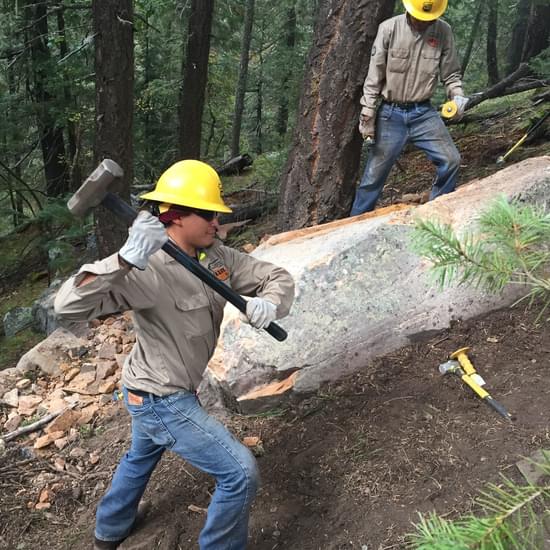




Why trail managers often engage Conservation Corps on maintenance projects, and why you might see more Corps on our trails.
by Hannah Traverse, Communications Manager, The Corps Network

Have you ever come across a crew of young adults working on a trail maintenance project? These young people are probably from a Conservation Corps. As a result of a partnership between the Federal Highway Administration (FHWA) and The Corps Network – the National Association of Service and Conservation Corps – you might soon see additional young adults working on America’s trails.
Conservation Corps are organizations that engage young people and recent veterans in service projects that address conservation and community needs. Through a term of service that could last from a few months to a year, Corps participants – or “Corpsmembers” – gain work experience and develop job skills. The Corps Network represents more than 130 Corps across the country, most of which are operated by nonprofits, universities, or state or local government. These Corps collectively enroll about 25,000 diverse Corpsmembers every year.
Depending on where the Corps is based, Corpsmembers could serve on a variety of projects, ranging from removing invasive species, to improving the energy efficiency of low-income homes. Many Corps partner with transportation and park managers to engage Corpsmembers in trail projects; sometimes this work is funded by the Recreational Trails Program (RTP). In 2018 alone, Corpsmembers helped build or improve nearly 14,000 miles of trails.
The FHWA and The Corps Network are working together to encourage more state and regional transportation agencies to partner with Corps on trail projects and workforce training. Why are Corps a practical partner on trail projects?
First, Corps can go beyond clearing downed limbs and overgrown vegetation; they can complete technical work, too. The most recent numbers show the National Park Service alone has more than $460 million in deferred maintenance on trails. This is more work than the agency can do on its own. Through partnerships with Corps, trail managers can address backlogged work sooner.
Corps typically bring a crew of up to about 10 Corps members to a project, supervised by two Crew Leaders. Corps have experience working on a range of trails projects, including constructing footbridges, installing drainage systems, building retaining walls, and even using GIS and other technology to assess trail sustainability and safety.
A new guide produced by The Corps Network and FHWA provides more than a dozen examples of Corps and trail agencies leveraging RTP funds to complete technical projects. One case study describes how Lassen Volcanic National Park worked with the California Conservation Corps to stabilize retaining walls and enhance safety on a popular trail. Another example describes how the Maryland Conservation Corps worked with Patapsco Valley State Park to create a wheelchair accessible path that included a guide-rope for visually impaired visitors. Another example outlines how the Hawaii Youth Conservation Corps worked with the state to install a boardwalk trail that protects sensitive vegetation.
Trail managers also work with Corps for cost reasons. Corps usually must bring matching dollars or in-kind support. This helps trail agencies extend limited funding further. In a comprehensive study, one federal agency found they saved an average of 83 percent by working with Corps instead of other contractors.
Additionally, Corps are a practical partner because they engage the next generation of trail and transportation professionals. Within the next five years, more than 30 percent of employees at the Departments of Transportation, Interior and Agriculture will be eligible for retirement. Corps provide a pathway into resource and infrastructure management positions. During their service, Corpsmembers gain hands-on experience, learn best practices, and often receive training or certification in the operation of equipment like chainsaws, pionjars, loaders, and paving tools. Another benefit is that Corps handle recruitment, training, supervision and insurance for their Corpsmembers, meaning trail managers can meaningful engage aspiring transportation professionals without a huge commitment of time or staff power.
Finally, Corps are capable of quality work. Every year, Conservation Corps are among the winners of the Coalition for Recreational Trails Achievement Award. In 2018, more than half of the 11 award-winning trail projects involved Conservation Corps.
Trail and transportation managers interested in learning more about Corps can consult The Corps Network’s guide Building the Future. The Corps Network also recently launched a listserv to connect state trail and transportation managers with Conservation Corps in their region. Additionally, The Corps Network and several Conservation Corps will present a webinar on December 5 as part of the Advancing Trails Webinar Series.
The Corps Network and several Conservation Corps will present a webinar on December 5, 2019.
Affinity and Identity-Based Crews and Programs
posted Feb 8, 2023
The purpose of this guide is to highlight the work of service and conservation Corps who develop and manage identity-based programs and crews, discuss the intention and purpose of these crews, why they are important, and how they have been transformational experiences for Corpsmembers and partners.
posted Mar 9, 2022
Successes and lessons from the COVID-19 Conservation Corps programs in Juneau, Anchorage, and Sitka that trained and employed out-of-work Alaskans in 2020.
posted Oct 1, 2021
This handbook defines the role of the SCA and the Programs’ policies and guidelines. It is to be referred to and followed. There are three sections- general information, a section specifically for the Leader Team Crew Leader, and a section specifically for the Leader Team Members.
Youth Conservation Corps Reference Manual: A Coordinator’s Guide
posted Oct 1, 2021
This handbook is intended to provide consistency among the National Park Service (NPS) units responsible for implementing the Youth Conservation Corps (YCC) and to offer guidance for establishing and operating the YCC throughout the NPS.
4,436 views • posted 08/28/2019